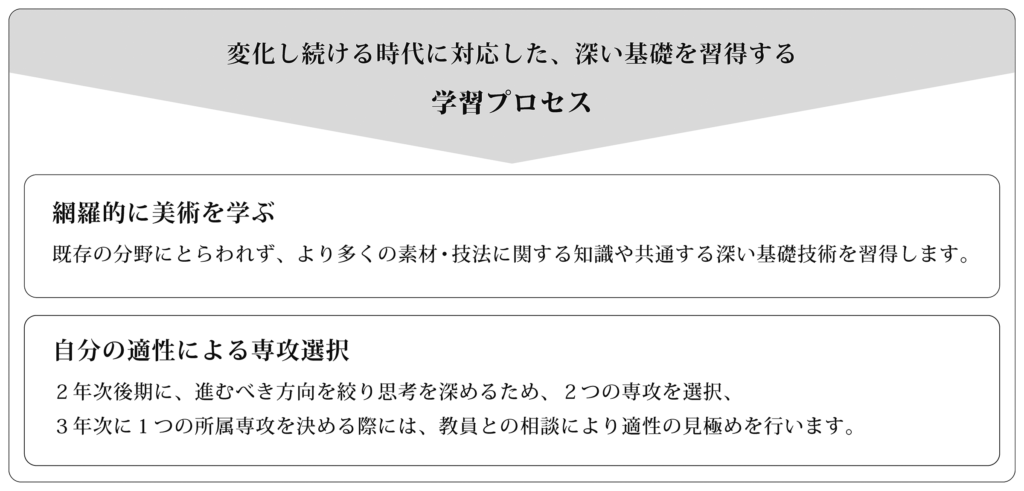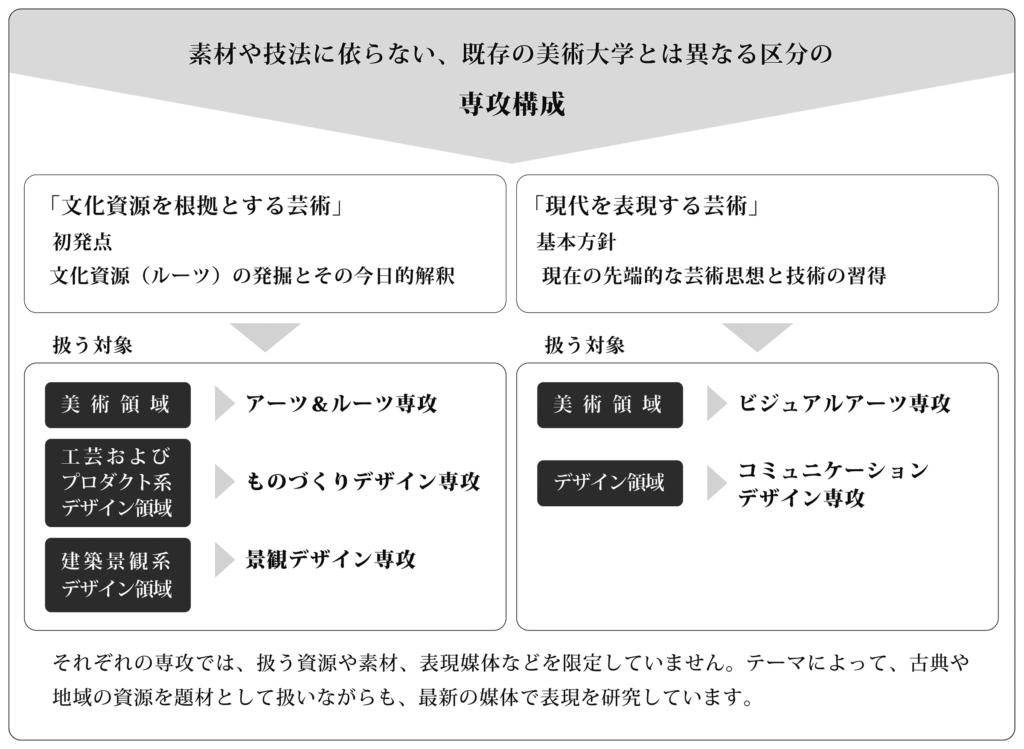Features of Akita University of Art (Faculty of Art, Department of Art)
At Akita University of Art, students take on the creation of new artistic fields unbound by preexisting concepts, in response to the needs of the modern world. We pursue the potential and commonality of art by taking advantage of the cultural resources of Akita, a land blessed by nature and rich traditions, to foster talented individuals who use their artistic sensibilities and creativity to make a difference in Japanese and global society.
The entrance examination is comprehensive, not specialized according to desired major. Upon admission, students examine basic concepts of quality, perspective, ideas, research, thought processes and communication, creating a foundation for more specialized study under instructors who work on the leading edges of their various fields. From the second half of the second year, students choose from one of five majors. Introductory courses establish a fundamental base from which students further develop individuality, quality, and orientation, aiming to become qualified personnel in specialized fields.
Four Founding Principles
1 The creation and investigation of new artistic fields
Akita University of Art re-examines the state of art education in modern Japan, in which genres such as “Japanese painting”, “oil painting”, “sculpture”, “craft”, “design”, and “architecture” are all well-established, and in which modern Western art and traditional Japanese art coexist. We seek to modernize the current system, in addition to creating and communicating new artistic values.
2 The utilization and promotion of Akita’s culture and traditions
Our university is pioneering the “decentralization of art” by promoting the development of artistic talent and production in Akita Prefecture, resisting the trend towards over-concentration of people, products and culture in Japan’s major population centers. This principle is based on a belief in the creation of new values through the rediscovery of local identities, as well as a belief that the richness of global culture lies precisely in the diversity of its communities. AUA aims to promote a regional renaissance through the rediscovery of Akita’s historical cultures, lifestyles and technologies, the re-evaluation of their artistic value, and their utilization in both modern Akita and as newly added dimensions to the larger fields of art and design.
3 The nurturing of global human resources capable of connecting Akita to the world
By providing our students with a deep understanding of reconstructed art fields and local cultures, as well as exposure to and interaction with the larger world, AUA molds open-minded individuals who are able to play an active role on the global stage. Students encounter various artistic roots while learning to accept and share a diversity of values, giving them the flexible thinking necessary, as artists and designers, to keep pace with constantly changing trends. In addition, the university itself communicates new values to the world through radical artistic expressions, while re-evaluating, reviving and modernizing the traditions of Akita with the aim of creating a richer global culture.
4 Contribution to and development with the local community
To fulfill their responsibilities as scholars of a public university, each faculty member of Akita University of Art is involved in social work related to his or her specialty. The university likewise aims to instill in its students a sense of community involvement by encouraging them to make meaningful contributions towards the promotion of local brands and industries, and the development of local artistic activities. AUA also actively seeks collaboration with universities both inside and outside the prefecture, as well as with private businesses, elementary, junior and senior high schools, art museums and other social educational institutions.
Five Majors
In their first and second years, students learn comprehensively about various materials and techniques, exploring their direction and field of study. Students select one of five courses as their major during the third to fourth year and begin practicing advanced concepts and techniques in their chosen field for the final project.

Year 1 and 2

Year 3 and 4

Ideas about the 5 majors

Flow of selecting majors (using the Manufacturing Design Major as an example)
Arts & Roots Major
This major involves investigating and researching historic cultural resources of the region through basic logic, production, and fieldwork in order to explore new artistic expressions through reevaluation.

Visual Arts Major
This major involves developing modern expressions through various materials and media by seeking new directions for modern art without being held captive to traditional materials, techniques, and expressions.

Manufacturing Design Major
This major involves using the cultural resources of Akita as the background for presenting manufacturing with new perspectives and values for building rich relationships.

Communication Design Major
This major enables comprehensive direction to create entire designs, such as excellent communicative expression and graphic design.

Landscape Design Major
This major involves studying methods of art and design that promote social innovation by recognizing the true nature of landscapes at their site through sense, knowledge, and experience.

2020.3.31

 Return to List
Return to List